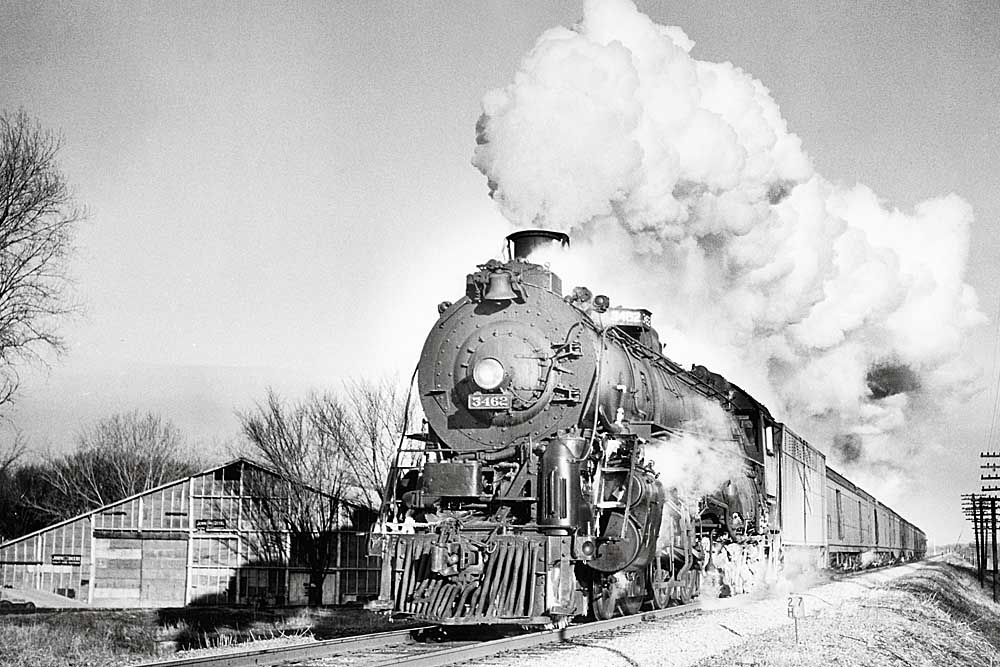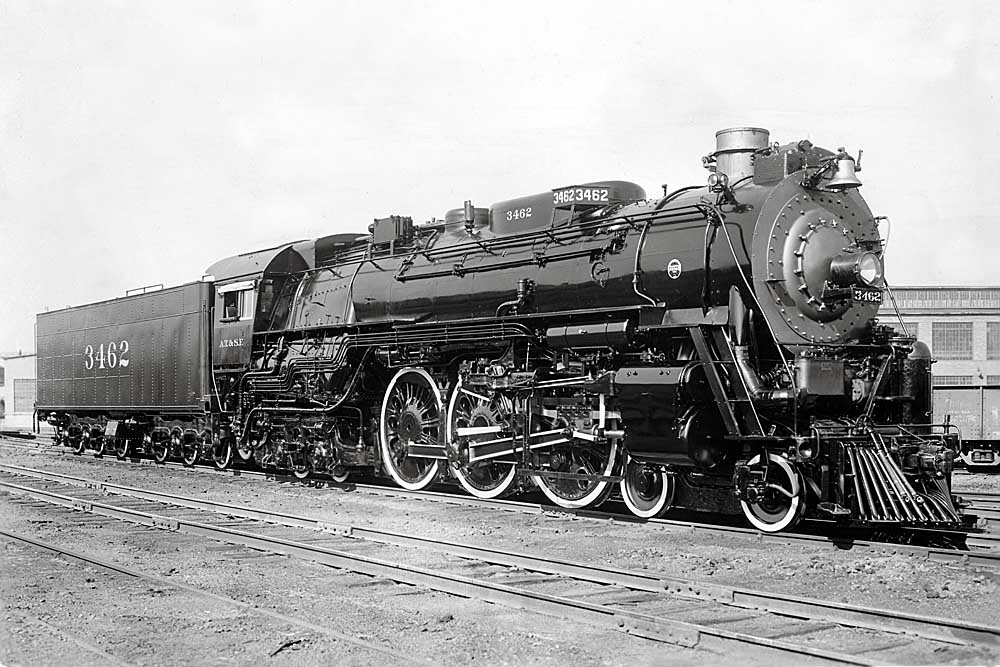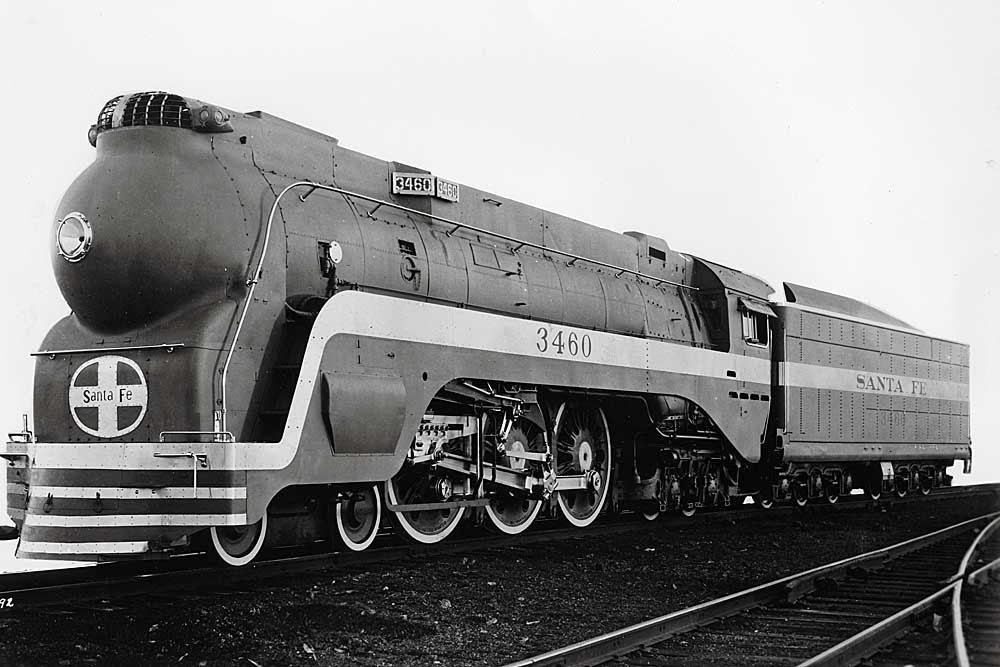Santa Fe 3460 Hudsons had an impact on the railroad much larger than their class size would indicate.

Mention the Hudson steam locomotive and the name “Santa Fe” likely won’t come up right away. To be sure, the Atchison, Topeka & Santa Fe Railway’s roster was light on 4-6-4s, just 16 of them. And they were overshadowed by the two other components of Santa Fe’s “Big Three,” the 5000-class 2-10-4s and the 2900-class 4-8-4s. But even at that small number, AT&SF made a mark with its Hudsons, first with 10 engines that qualify as among the earliest with the wheel arrangement, and later with 6 justifiably called “Super Hudsons,” including one famous streamlined example called the “Blue Goose.”
Those first 10 Hudsons came from Baldwin in 1927 and were numbered in the 3450 class, earmarked mainly for service between Kansas City and La Junta, Colo. They were reliable engines that fulfilled the railroad’s mission to provide higher speeds and greater horsepower for a rapidly expanding passenger service, taking some of the burden off Santa Fe’s huge roster of 274 Pacifics employed in various classes between 1903 and 1924; the largest 4-6-2s were 50 in the 3400 class. In fact, the 3450-class Hudsons that followed were little more than large Pacifics, “slide-ruled” up from the 3400 class by the railroad’s mechanical department. Initially equipped with 74-inch drivers, the older Hudsons were rebuilt in the late 1930s with 79-inch drivers and improvements to boilers and external plumbing.

What came next was a group of engines that, while small in number, were huge in their impact. Built by Baldwin in 1937, the six Santa Fe 3460 Hudsons were similar to 4-6-4s built for the Milwaukee Road and Chicago & North Western, all with 84-inch drivers and high boiler pressures of 300 psi. At 412,380 pounds of total engine weight, Santa Fe’s were among the biggest of all 4-6-4s, only slightly lighter than those of the heaviest class, Chesapeake & Ohio’s L2a engines. Santa Fe’s 3460s were thoroughly modern, with roller bearings on all axles and Baldwin disc drivers and one-piece cast engine beds with integral cylinders; their imposing size gave them an appearance similar to the railroad’s 3750-class of 4-8-4s. That’s how big they looked. No wonder they came to be known as Super Hudsons.
Santa Fe’s newer 4-6-4s turned heads the moment they showed up on the property. Designated for use on the railroad’s premier passenger trains out of Chicago — notably the Chief — they regularly made the 990-mile run without engine change all the way La Junta, mountain territory west of which required 4-8-4s. In one famous demonstration in December 1937, No. 3461 ran all the way from Los Angeles to Chicago without change on mail train No. 8. Initially held to 80 mph speeds, in 1938 the expanded use of Automatic Train Stop allowed the 3460 class to do 90 mph east of Kansas City and 100 mph to the west. Just how fast were they? Santa Fe historian Lloyd Stagner quoted an AT&SF engineman saying, “We’ll never know, because nobody will have the guts to open one all the way up.”

One should not consider Santa Fe 3460 Hudsons without making special mention of the class engine, the Blue Goose, so called for its lightweight, two-tone blue shroud, blue-gray running gear, and silver detailing. Designed to match up well with new streamlined stainless-steel passenger cars, the 3460 appeared frequently in publicity pictures. Unabashed about the fact it was a late-model steam locomotive, Santa Fe often posed the 4-6-4 with its latest diesels, including one taken in Chicago showing the 3450 flanked on both sides by Warbonnet E1 cab units assigned to the Super Chief and El Capitan.
As good as Santa Fe’s Hudsons were, they could not escape the tide of mechanical history. The railroad moved quickly toward dieselization beginning in 1940, and by 1946 the regearing of FT diesels for passenger service bumped the 4-6-4s to such lesser trains as the Grand Canyon, Scout, and California Limited. Further expansion of diesels led to further demotions to the Kansas City-Oklahoma City Antelope and the Kansas City-Tulsa Oil Flyer. The last revenue run for a 3460-class engine came in December 1953, although all six hung around on the property until five were scrapped in 1956. The lone survivor, No. 3463, was donated to the city of Topeka, where it remains today on display in a park setting.














Santa Fe men did not call 4-6-4s “Hudsons.” They called them “Big Pacifics.” Likewise they did not call 4-8-4s “Northerns” – they called them “Big Mountains.” In each case they were evolutions of the engine before. Besides, New York Central had Hudsons, and this was the Santa Fe. Likewise there were no Berkshires on the Santa Fe though they did have a few “Heavy Mikes.”